E-bike Battery Market Size
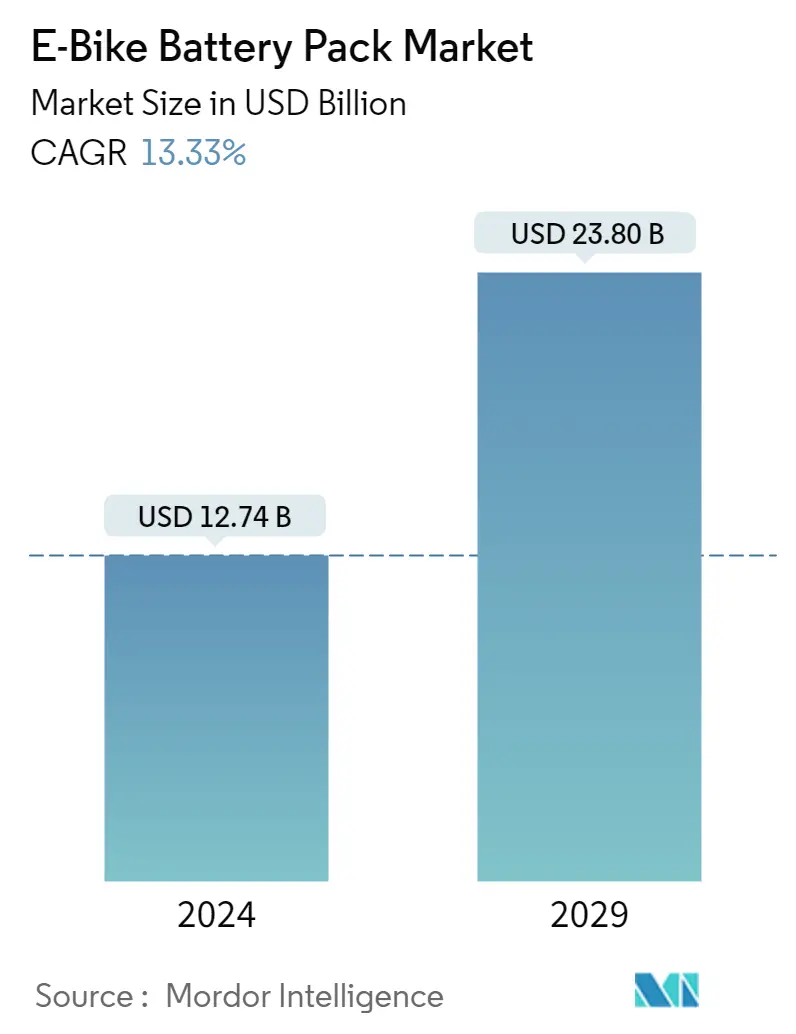
| Study Period | 2020 - 2029 |
| Market Size (2024) | USD 12.74 Billion |
| Market Size (2029) | USD 23.80 Billion |
| CAGR (2024 - 2029) | 13.33 % |
| Fastest Growing Market | Asia-Pacific |
| Largest Market | Asia-Pacific |
Major Players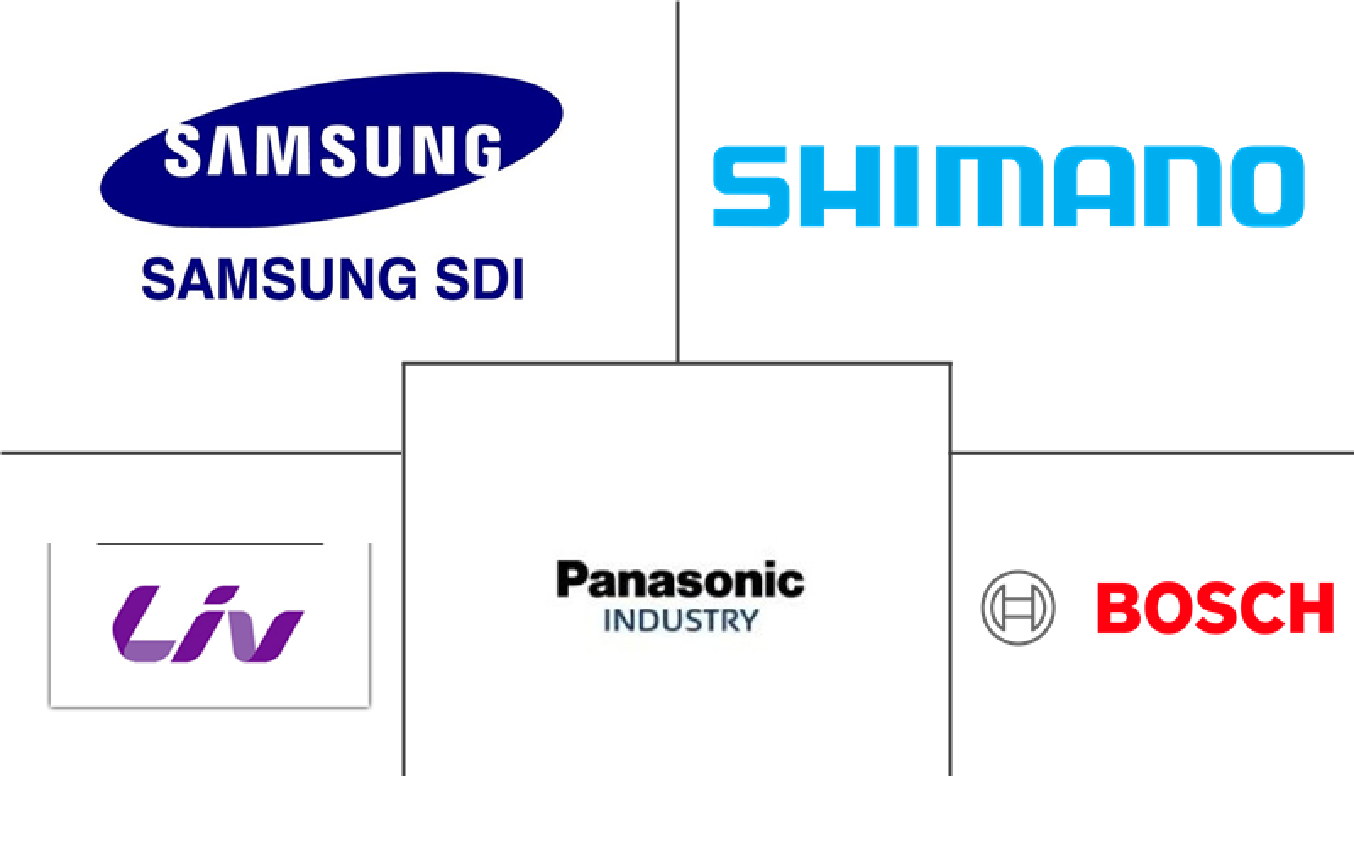
*Disclaimer: Major Players sorted in no particular order |
E-bike Battery Market Analysis
The E-Bike Battery Pack Market size is estimated at USD 12.74 billion in 2024, and is expected to reach USD 23.80 billion by 2029, growing at a CAGR of 13.33% during the forecast period (2024-2029).
In 2020, the e-bike battery pack market witnessed a steady downfall in global demand due to the COVID-19 outbreak. Governments across the nations issued strict policies and regulatory frameworks to lower infection rates. However, on a microscale, the pandemic had a positive impact on electric bike sales. The growing health concerns resulted in more sales of e-bikes. For instance,
- In 2020, about 1.95 million e-bikes were sold in Germany, up from 1.36 million in 2019.
The motor and battery are the two key components of an e-bike. Choosing the right battery pack plays a crucial role in purchasing an e-bike. The battery is also the costliest component of an e-bike. Currently, there are 24V, 36V, 48V, 52V, and 72V batteries available for e-bike applications.
Most legal electric bike kits use a 36V battery, and the more powerful motors may use a 48V or even a 52V battery. For very high-performance e-bikes, voltages can go up to 72V and beyond.
Over the long term, growing e-bike sales, a rise in e-bike sharing services, government initiatives to promote electromobility, and new launches of battery packs are expected to result in healthy sales of e-bike battery packs.
Key players are launching new products to address the growing market for e-bike battery packs and gain more market share. For instance,
- In July 2022, Appear Inc. launched new graphene battery packs in 36V, 48V, 60V, 64V, and 72V ratings for E-Bikes, E-Scooters, and Pedelecs.
- In July 2022, UK-based e-bike conversion company Swytch launched its new e-bike conversion kit.
Geographically, Asia-Pacific was predicted to be the largest market for e-bike battery packs due to the widespread adoption of e-bikes, many major cities offering e-bike sharing services, rapid urbanization, growing traffic congestion and vehicular pollution, the large presence of battery OEMs, and growing usage of e-bikes by E-commerce and food delivery companies for last-mile delivery applications.
Europe is predicted to be the next biggest market for e-bike battery packs due to the rising sales of e-bikes, growing health consciousness amongst the general population, and the growing tendency to use e-bikes for adventure activities like mountaineering.
Thus, the confluence of the aforementioned factors is expected to produce significant growth in the e-bike battery pack market.
E-bike Battery Market Trends
This section covers the major market trends shaping the E-Bike Battery Pack Market according to our research experts:
Growing Demand for Lithium-ion Batteries
It is anticipated that, between 2021 and 2023, more than 130 million e-bikes (using all battery technologies) will be sold. In 2023, e-bike sales are expected to top 40 million units worldwide. The majority of the e-bikes sold each year used heavy lead-acid batteries. Over the forecast period, about two-fifths of all e-bikes sold globally are anticipated to feature lithium-ion batteries, with the proportion of lithium-ion batteries-powered e-bikes starting at about 25% in 2021 and rising to more than 60% during the forecast period.
E-bikes have efficient motors and the largest integrated batteries. Even then, for longer rides, the demand is unmet. To address this challenge, an additional e-bike range extender is being launched in the market so that the biker does not have to worry about the battery status. For instance,
- In February 2022, Priority Bicycles launched a range extender for its Current range of e-bikes. The range extender is a 500 kWh battery and will double the bike's standard range to 64 kilometers and 80 kilometers if used on lower power.
Although e-bikes batteries were produced mainly by established players in the past, many small and medium companies have also started using innovative methods to create more durable batteries to compete in the highly competitive market.
Key players are working to enhance the overall range and performance of the battery by launching new batteries. For instance,
- In September 2022, Bosch released its new race-oriented drive system, the Bosch Performance Line CX Race Limited Edition. In Race mode, the new system will have up to 400% support of the rider's power, meaning riders can get up to speed faster.
- In September 2022, Yamaha Bicycles launched the updated Yamaha PW series S2 drive unit with 75 Nm torque. The new motor offers 7% more torque, 16% weight reduction, and 20% less volume than the previous generation PW-ST motor.
Thus, the aforementioned factors are projected to propel the market for e-bike battery packs market over the next five years.
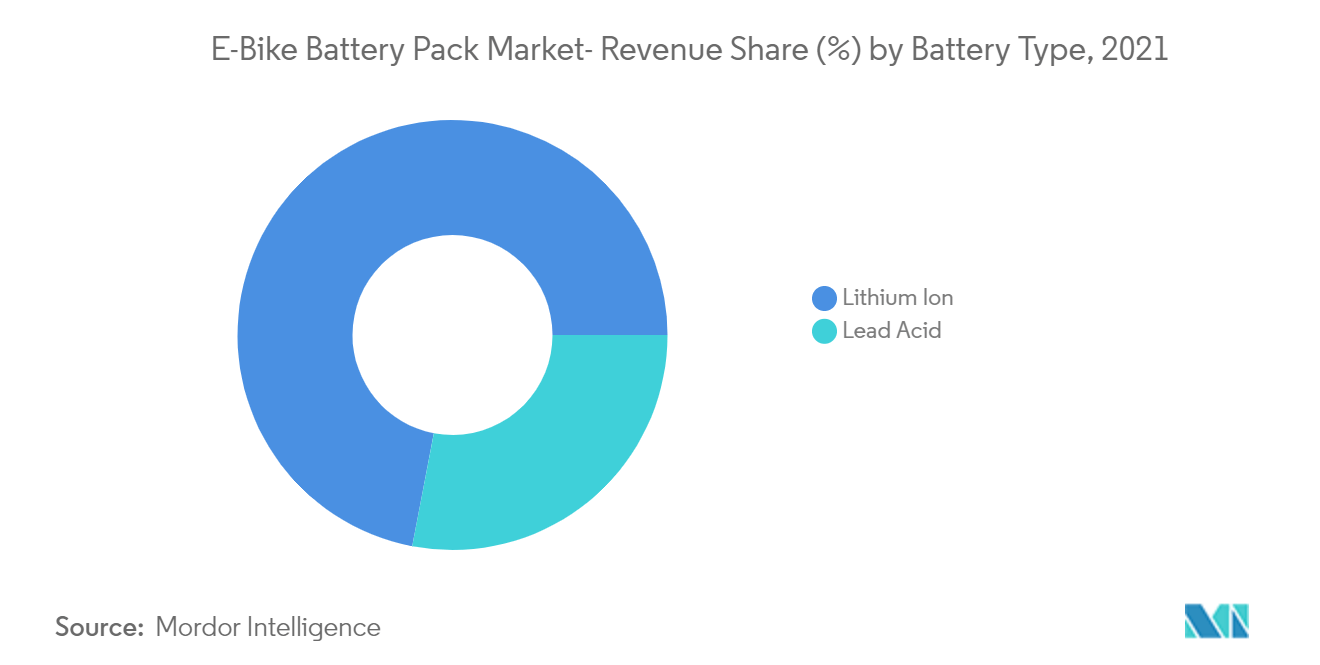
Asia-Pacific to Hold Major Market Share
In 2021, Asia-Pacific was the largest market for e-bike battery packs. China has contributed to more than 50% of the Asia-Pacific e-bike battery pack market during 2018-2020, owing to its high consumption of electric bikes, to tackle heavy traffic conditions and growing vehicle pollution in the country.
China is the global market leader for e-bikes and e-bike components, especially the battery. The players in the market are constantly investing in R&D capabilities and production capacities to stay ahead of the competition. For instance, Contemporary Amperex Technology, Tianneng Battery, and Shenzhen Topband are adding extra production lines for LFP (lithium iron phosphate) batteries, majorly for e-bicycle applications.
The COVID-19 outbreak led to a sharp rise in the demand for electric bikes in China. The MaaS or mobility-as-a-service concept is gaining traction in China, and bike-sharing players such as Meituan's Mobike put several electric bikes on roads to cater to the rising demand in 2021. Bike-sharing companies are collaborating with battery makers to swap discharged and faulty batteries at dedicated kiosks. Investments are being made to strengthen charging infrastructure, and the use of technology such as artificial intelligence is helping predict demand more precisely.
In addition, Japan remained the second most potential country for e-bike battery packs in the Asia-Pacific region. Major factors driving the growth of the market in the country are the expanding customer base across all age groups and the penetration of electric sports bicycles.
Thus, Asia-Pacific is anticipated to remain the largest market for e-bike battery packs in the world due to the above factors.
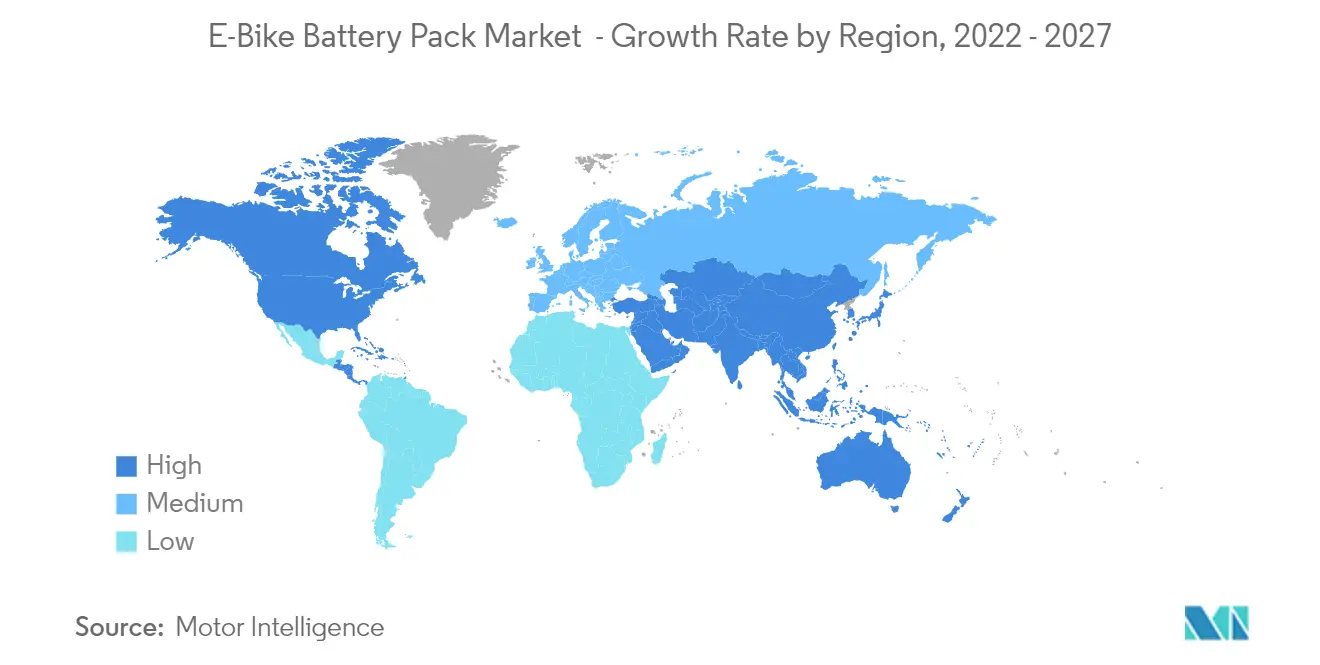
E-bike Battery Industry Overview
The e-bike battery pack market is moderately consolidated, with major players holding most of the market share. Some of the major players include Bosch, Liv Cycling (EnergyPak), Panasonic, Samsung SDI, and Shinamo Inc. These companies are engaging in new product launches, joint ventures, and mergers and acquisitions to expand their business activities and cement their market position. For instance,
- In September 2022, the US-based e-bike company Optibike launched a 2,500W electric bicycle motor that claims to have the highest power-to-weight ratio in the world.
- In July 2022, ZappBatt and Toshiba signed a partnership agreement to develop long-lasting e-bike batteries using ZappBatt's proprietary AI software and Toshiba's lithium titanium oxide (LTO) battery cells, which will make lithium titanium oxide to be faster, smarter, and more cost-effective battery system.
E-bike Battery Market Leaders
-
Robert Bosch GmbH
-
Panasonic Industries
-
Samsung SDI
-
Shimano Inc.
-
Liv Cycling (Energy Pak)
*Disclaimer: Major Players sorted in no particular order
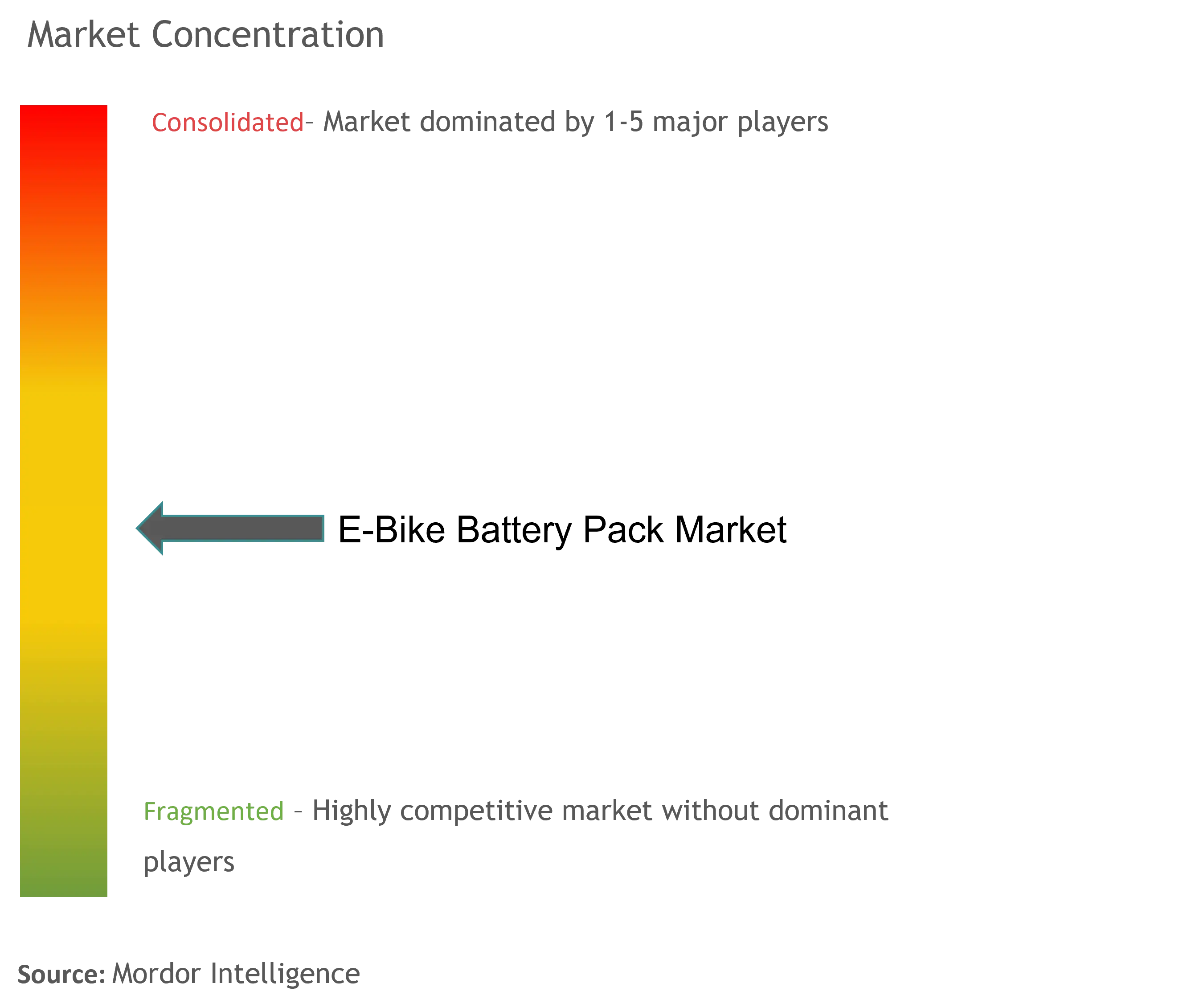
E-bike Battery Market News
- Aug 2022: Bosch Mobility Solutions announced to set up an e-bike battery production plant in Slovakia. The plant will come up in eastern Slovakia and will employ 400 people when it becomes operational in 2023.
- Aug 2022: Lectric introduced new batteries for XP 1.0 and 2.0 models with 45% more range.
- Apr 2022: ZappBatt launched super fast charging, long-life battery for e-bikes, which can be charged fully within 20 minutes.
- Apr 2022: Green Cell opened their new plant for manufacturing e-bike batteries located at Balice in Krakow, Poland, with an annual production capacity of 50000 batteries.
E-bike Battery Market Report - Table of Contents
1. INTRODUCTION
- 1.1 Study Assumptions
- 1.2 Scope of the Study
2. RESEARCH METHODOLOGY
3. EXECUTIVE SUMMARY
4. MARKET DYNAMICS
- 4.1 Market Drivers
- 4.2 Market Restraints
-
4.3 Porter's Five Forces Analysis
- 4.3.1 Threat of New Entrants
- 4.3.2 Bargaining Power of Buyers/Consumers
- 4.3.3 Bargaining Power of Suppliers
- 4.3.4 Threat of Substitute Products
- 4.3.5 Intensity of Competitive Rivalry
5. MARKET SEGMENTATION
-
5.1 Battery Type
- 5.1.1 Lithium-ion Battery
- 5.1.2 Lead Acid Battery
- 5.1.3 Other Battery Types
-
5.2 Battery Pack Position Type
- 5.2.1 Rear Carrier
- 5.2.2 Down Tube
- 5.2.3 In Frame
-
5.3 Geography
- 5.3.1 North America
- 5.3.1.1 United States
- 5.3.1.2 Canada
- 5.3.1.3 Mexico
- 5.3.1.4 Rest of North America
- 5.3.2 Europe
- 5.3.2.1 United Kingdom
- 5.3.2.2 Germany
- 5.3.2.3 France
- 5.3.2.4 Italy
- 5.3.2.5 Rest of Europe
- 5.3.3 Asia-Pacific
- 5.3.3.1 China
- 5.3.3.2 India
- 5.3.3.3 Japan
- 5.3.3.4 South Korea
- 5.3.3.5 Rest of Asia-Pacific
- 5.3.4 Middle East and Africa
- 5.3.4.1 South Africa
- 5.3.4.2 United Arab Emirates
- 5.3.4.3 Saudi Arabia
- 5.3.4.4 Egypt
- 5.3.4.5 Rest of Middle East and Africa
- 5.3.5 South America
- 5.3.5.1 Brazil
- 5.3.5.2 Argentina
- 5.3.5.3 Rest of South America
6. COMPETITIVE LANDSCAPE
- 6.1 Vendor Market Share
-
6.2 Company Profiles*
- 6.2.1 E-bike Battery Pack Manufacturers
- 6.2.1.1 Samsung SDI Co. Ltd
- 6.2.1.2 Yamaha Corporation
- 6.2.1.3 Yoku Energy (Zhangzhou) Co. Ltd
- 6.2.1.4 Kingbo Power Technology Co. Limited
- 6.2.1.5 Liv Cycling
- 6.2.1.6 Shimano Inc.
- 6.2.1.7 Panasonic Industry Europe GmbH
- 6.2.1.8 BMZ GmbH
- 6.2.1.9 Mahle GmbH
- 6.2.1.10 Varta AG
- 6.2.1.11 Johnson Matthey
- 6.2.1.12 Solaremobility (Fotona Mobility)
- 6.2.1.13 Enerpower
- 6.2.2 E-bike Manufacturers
- 6.2.2.1 Giant Bicycles Co. Ltd
- 6.2.2.2 Merida Industry Co. Ltd
- 6.2.2.3 Riese & Muller
- 6.2.2.4 Fritzmeier Systems GmbH & Co. KG (M1 Sporttechnik)
- 6.2.2.5 Yamaha Bicycles
- 6.2.2.6 Trek Bikes
- 6.2.2.7 Cannondale Bicycle Corporation
- 6.2.2.8 PON Bicycle Holding BV
- 6.2.2.9 VanMoof BV
- 6.2.2.10 Coboc
- 6.2.2.11 Ampler Bikes
- 6.2.2.12 Cowboy
- 6.2.2.13 Desiknio
- 6.2.2.14 Accell Group NV
- 6.2.2.15 Cycle Europe AB
- 6.2.2.16 Decathlon SA
- 6.2.2.17 Cross Ltd
- 6.2.2.18 Multicycle (Kross SA)
- 6.2.2.19 ZEG
- 6.2.2.20 Prophete GmbH u. Co. KG
- 6.2.2.21 MarkenTechnikService GmbH (MTS) Group (Merger of Inter-Union Technohandel GmbH and SPA SystemPartner GmbH & Co. KG)
- 6.2.2.22 Specialized Bicycle Components Inc.
- 6.2.2.23 Manufacture Française du Cycle (MFC)
- 6.2.2.24 Scott Sports
- 6.2.2.25 Cube GmbH & Co. KG
7. MARKET OPPORTUNITIES AND FUTURE TRENDS
** Subject To AvailablityE-bike Battery Industry Segmentation
An E-bike battery pack is a rechargeable battery pack used to power e-bikes. Batteries vary according to the voltage, total charge capacity (amp hours), weight, the number of charging cycles before performance degrades, and ability to handle over-voltage charging conditions.
The E-Bike Battery Pack Market is Segmented by Battery Type (Lithium-ion Battery, Lead Acid Battery, and Other Battery Types), Battery Pack Position Type (Rear Carrier, Down Tube, and In-tube Battery Pack), and Geography (North America, Europe, Asia-Pacific, Middle East and Africa, and South America). The report offers market size and forecast in value (USD million) for all the above segments. The report also offers the market dynamics, latest trends, size, share, and industry overview.
| Battery Type | Lithium-ion Battery | |
| Lead Acid Battery | ||
| Other Battery Types | ||
| Battery Pack Position Type | Rear Carrier | |
| Down Tube | ||
| In Frame | ||
| Geography | North America | United States |
| Canada | ||
| Mexico | ||
| Rest of North America | ||
| Geography | Europe | United Kingdom |
| Germany | ||
| France | ||
| Italy | ||
| Rest of Europe | ||
| Geography | Asia-Pacific | China |
| India | ||
| Japan | ||
| South Korea | ||
| Rest of Asia-Pacific | ||
| Geography | Middle East and Africa | South Africa |
| United Arab Emirates | ||
| Saudi Arabia | ||
| Egypt | ||
| Rest of Middle East and Africa | ||
| Geography | South America | Brazil |
| Argentina | ||
| Rest of South America |
E-bike Battery Market Research FAQs
How big is the E-Bike Battery Pack Market?
The E-Bike Battery Pack Market size is expected to reach USD 12.74 billion in 2024 and grow at a CAGR of 13.33% to reach USD 23.80 billion by 2029.
What is the current E-Bike Battery Pack Market size?
In 2024, the E-Bike Battery Pack Market size is expected to reach USD 12.74 billion.
Who are the key players in E-Bike Battery Pack Market?
Robert Bosch GmbH, Panasonic Industries, Samsung SDI, Shimano Inc. and Liv Cycling (Energy Pak) are the major companies operating in the E-Bike Battery Pack Market.
Which is the fastest growing region in E-Bike Battery Pack Market?
Asia-Pacific is estimated to grow at the highest CAGR over the forecast period (2024-2029).
Which region has the biggest share in E-Bike Battery Pack Market?
In 2024, the Asia-Pacific accounts for the largest market share in E-Bike Battery Pack Market.
What years does this E-Bike Battery Pack Market cover, and what was the market size in 2023?
In 2023, the E-Bike Battery Pack Market size was estimated at USD 11.24 billion. The report covers the E-Bike Battery Pack Market historical market size for years: 2020, 2021, 2022 and 2023. The report also forecasts the E-Bike Battery Pack Market size for years: 2024, 2025, 2026, 2027, 2028 and 2029.
E-bike Battery Industry Report
Statistics for the 2024 E-bike Battery market share, size and revenue growth rate, created by Mordor Intelligence™ Industry Reports. E-bike Battery analysis includes a market forecast outlook to 2029 and historical overview. Get a sample of this industry analysis as a free report PDF download.



